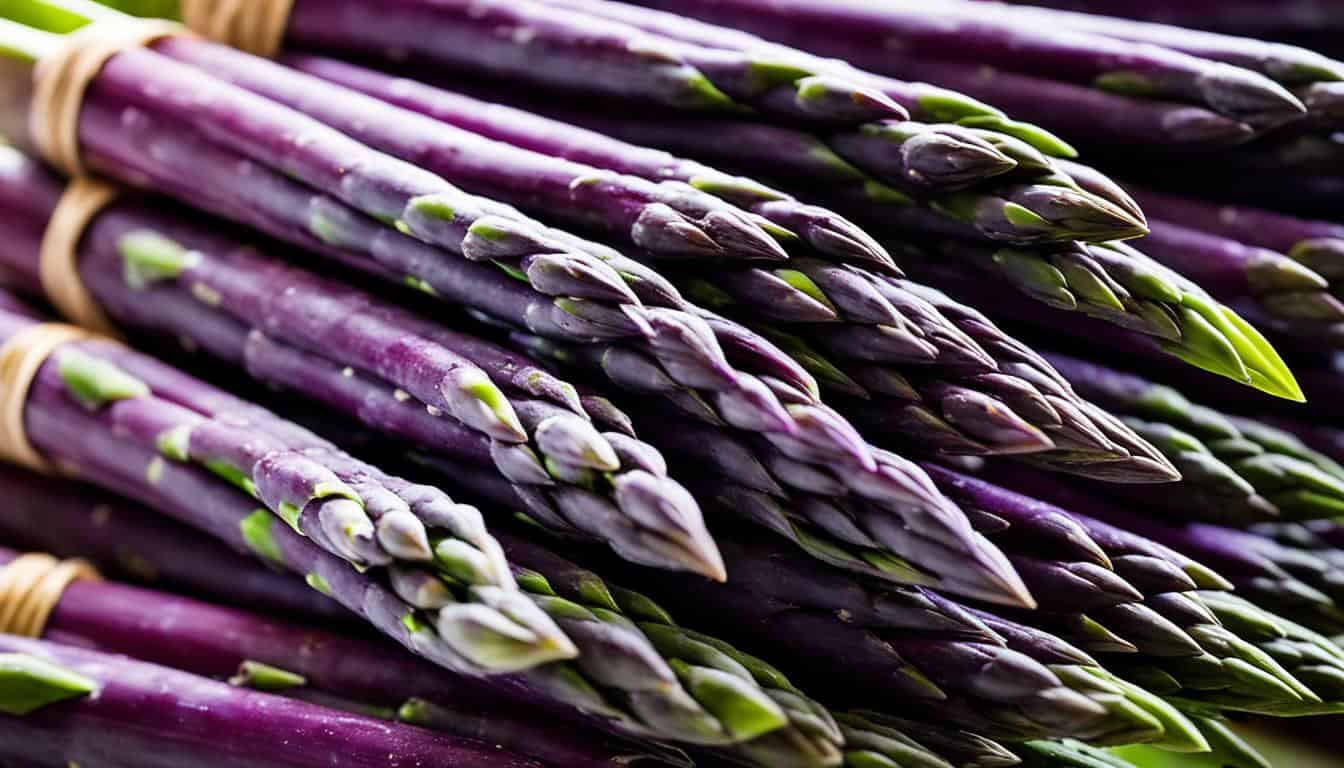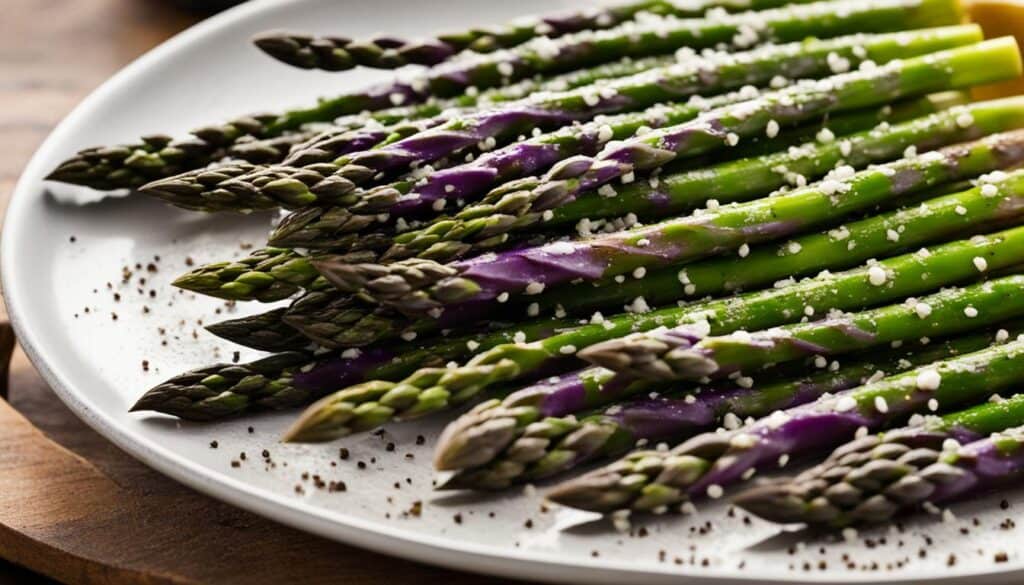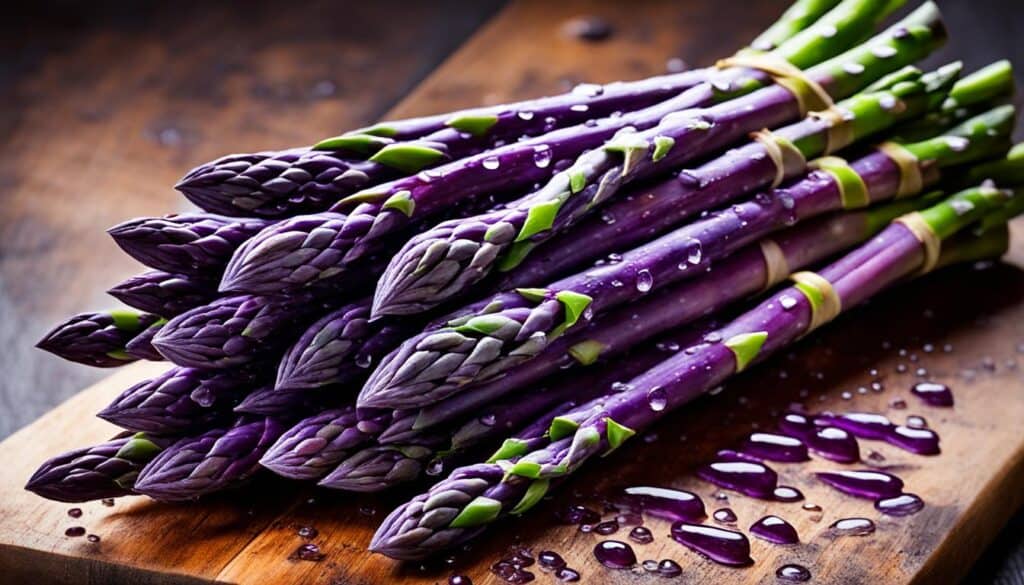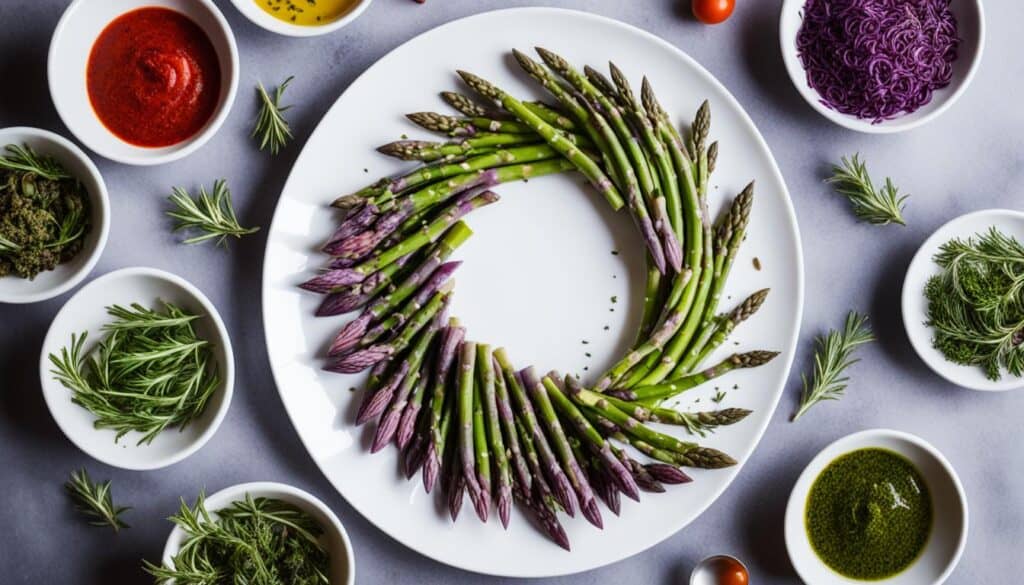Did you know that purple asparagus is not just a visually stunning vegetable, but it also offers numerous health benefits? This unique variety of asparagus is packed with powerful antioxidants, vitamins, and minerals that can support your overall well-being. Whether you’re a culinary enthusiast or someone looking to boost their nutrient intake, you’ll be amazed by what purple asparagus has to offer.
Key Takeaways:
- Purple asparagus is a unique variety that stands out with its vibrant purple color.
- It is rich in antioxidants, including anthocyanins, which help fight free-radical damage.
- Purple asparagus is packed with nutrients like fiber, protein, B vitamins, copper, and iron.
- Incorporating purple asparagus into your meals can support digestion and promote overall health.
- Explore various cooking methods and recipes to enjoy the unique flavor and texture of purple asparagus.
Differences Between Purple, White, and Green Asparagus
Asparagus comes in a variety of colors, each with its own distinct characteristics. Understanding the differences between purple, white, and green asparagus can help you choose the perfect variety for your culinary adventures.
White asparagus:
White asparagus is a delicacy known for its mild and delicate flavor. It is created by covering the budding spears with dirt, preventing the process of photosynthesis. This lack of exposure to sunlight keeps the asparagus pale in color and gives it a more subdued taste. White asparagus is often enjoyed in traditional European dishes and pairs well with creamy sauces and savory flavors.
Green asparagus:
Green asparagus is the most common type found in grocery stores and farmers’ markets. It is harvested when the spears have grown above the ground and are exposed to sunlight. Green asparagus has a vibrant color and a robust flavor. It is packed with essential vitamins, including vitamins C, E, and K, as well as beta-carotene. Its tangy and slightly bitter taste adds a delightful crunch to salads and stir-fries.
Purple asparagus:
Purple asparagus stands out with its vibrant hue and unique flavor profile. Unlike white asparagus, it is grown above ground, allowing it to develop its rich purple color. The anthocyanins present in purple asparagus not only give it its beautiful pigment but also offer antioxidant benefits. With a slightly sweet and nutty taste, purple asparagus adds a touch of elegance and visual appeal to any dish.
To better understand the differences between these asparagus varieties, take a look at the table below:
| Asparagus Variety | Color | Flavor | Nutritional Benefits |
|---|---|---|---|
| White Asparagus | Pale | Mild and delicate | Rich in fiber and folate |
| Green Asparagus | Vibrant green | Robust and slightly bitter | High in vitamins C, E, and K, and beta-carotene |
| Purple Asparagus | Vibrant purple | Slightly sweet and nutty | Loaded with antioxidants and vitamins |
Now that you know more about the fascinating differences between purple, white, and green asparagus, you can select the variety that suits your taste preferences and culinary endeavors.
Explore the vibrant world of asparagus and discover new and delicious ways to enjoy this versatile vegetable.
Nutritional Profile of Purple Asparagus
Purple asparagus is not only visually appealing but also highly nutritious. It is a fantastic addition to a healthy diet due to its low calorie content, with only 26 calories per cup. This makes it an excellent choice for those looking to maintain a healthy weight without sacrificing taste or nutrition.
One of the standout features of purple asparagus is its fiber content. With 3 grams of fiber per cup, it provides a good source of dietary fiber. Fiber is essential for promoting healthy digestion and supporting overall gut health. Incorporating purple asparagus into your meals can help keep you feeling satisfied and support a well-functioning digestive system.
Alongside fiber, purple asparagus is packed with essential vitamins that are vital for our overall well-being. It is particularly rich in B vitamins, which play a crucial role in energy production and maintaining proper brain function. Additionally, purple asparagus is an excellent source of vitamin C, a powerful antioxidant that supports a robust immune system.
Purple asparagus also contains important minerals for various bodily processes. It is a good source of copper, which is involved in energy production and helps form collagen, a protein that supports healthy skin and connective tissues. Furthermore, purple asparagus contains iron, an essential mineral for transporting oxygen throughout the body, supporting energy levels and preventing iron-deficiency anemia.
Celebrating the Nutritional Benefits of Purple Asparagus
“Purple asparagus is not only visually stunning but also a nutritional powerhouse. Its low calorie and high fiber content make it an excellent choice for maintaining a healthy weight and supporting digestion. With an array of vitamins, including B vitamins and vitamin C, as well as important minerals like copper and iron, purple asparagus offers a range of health benefits.”
| Nutrient | Amount per Cup |
|---|---|
| Calories | 26 |
| Fiber | 3 grams |
| Vitamin B1 (Thiamine) | 0.2 mg |
| Vitamin B2 (Riboflavin) | 0.2 mg |
| Vitamin B3 (Niacin) | 0.7 mg |
| Vitamin B6 | 0.1 mg |
| Vitamin C | 8 mg |
| Copper | 0.2 mg |
| Iron | 1.4 mg |
Table: Nutritional content of purple asparagus per cup.
Incorporating purple asparagus into your meals is a simple and delicious way to enhance your overall nutrition. Whether you steam it, roast it, or add it to stir-fries and salads, you’ll be benefiting from its rich nutritional value. Enjoy the vibrant flavors and healthful advantages that purple asparagus brings to your table.
Antioxidant Benefits of Purple Asparagus
Purple asparagus is not only visually stunning but also offers a wealth of health benefits. One of its key advantages comes from its abundance of antioxidants, which can help protect the body against damage caused by free radicals. These antioxidants include vitamins C and E, flavonoids, and polyphenols.
Antioxidants play a vital role in maintaining overall health and well-being. By neutralizing free radicals, they can prevent oxidative stress, which has been linked to chronic diseases such as cancer, heart disease, and inflammation.
Researchers have discovered that purple asparagus contains anthocyanins, powerful pigments responsible for its striking color. These anthocyanins possess potent antioxidant properties, contributing to the vegetable’s ability to combat harmful free radicals.
Furthermore, studies have shown that anthocyanins may help lower blood pressure, reduce the risk of cardiovascular issues, and improve heart health. These remarkable compounds also exhibit anti-inflammatory properties, potentially reducing inflammation in the body and alleviating associated symptoms.
Quote
“The antioxidant properties of purple asparagus can help protect cells and reduce the risk of chronic diseases associated with oxidative stress. Its anthocyanins may also have additional benefits for heart health and inflammation reduction.” – Dr. Jane Johnson, Nutritionist
Antioxidant Benefits of Purple Asparagus
- Protects against oxidative stress
- Reduces the risk of chronic diseases
- Supports heart health
- Reduces inflammation
To reap the antioxidant benefits of purple asparagus, it’s recommended to incorporate it into your regular diet. Enjoy it as a side dish, add it to salads, or include it in stir-fries for a burst of vibrant color and unique flavor. Let the power of purple asparagus fortify your body and elevate your well-being.
| Nutrient | Amount per Cup (205g) |
|---|---|
| Antioxidants (including vitamins C and E, flavonoids, and polyphenols) | Potent |
| Anthocyanins | Abundant |
Cooking Tips for Purple Asparagus
When it comes to cooking purple asparagus, it’s important to preserve its crispness and vibrant color. Follow these tips to bring out the best in this unique and nutritious vegetable.
Grilling or Sautéing
One of the best ways to cook purple asparagus is by grilling or sautéing it. This method enhances the natural flavor and texture while adding a touch of smokiness.
To grill purple asparagus, preheat your grill to medium-high heat. Brush the spears with a little olive oil or vegetable stock to prevent sticking and enhance the flavor. Grill them for about two minutes on each side, turning occasionally, until they are tender but still retain some crispness.
Using Purple Asparagus in Recipes
Purple asparagus is incredibly versatile and can be used in a variety of dishes. Its slightly sweet and nutty flavor adds a unique twist to any recipe.
Try incorporating purple asparagus into salads, frittatas, omelets, and stir-fries. Its vibrant color will make your dishes visually appealing while providing a nutritional boost. Experiment with different cooking methods and ingredients to discover your favorite way to enjoy purple asparagus.
Here’s a simple yet delicious recipe to get you started:
Purple Asparagus Salad:
- Ingredients:
- 1 bunch of purple asparagus, trimmed
- 2 cups mixed salad greens
- 1/4 cup cherry tomatoes, halved
- 1/4 cup crumbled feta cheese
- 2 tablespoons balsamic vinegar
- 1 tablespoon extra-virgin olive oil
- Salt and pepper to taste
- Instructions:
- Grill or sauté the purple asparagus spears as mentioned above. Let them cool slightly.
- In a large bowl, combine the mixed salad greens and cherry tomatoes.
- Add the grilled purple asparagus and crumbled feta cheese.
- In a small bowl, whisk together the balsamic vinegar, olive oil, salt, and pepper.
- Drizzle the dressing over the salad and toss gently to combine.
- Serve and enjoy!
Explore the world of purple asparagus in your cooking adventures and discover the endless possibilities it offers.
Where to Buy Purple Asparagus
If you’re looking to add some vibrant purple asparagus to your meals, you might wonder where to find this unique variety. While purple asparagus may not be as readily available as its green counterpart, there are still a few options for purchasing this colorful veggie.
Local Farmers’ Markets
One great place to start your search for purple asparagus is your local farmers’ market. Many farmers’ markets carry a variety of asparagus, including the purple variety. Connecting with local farmers not only supports the community but also allows you to enjoy fresh and seasonal produce.
Specialty Grocery Stores
Specialty grocery stores that focus on organic or gourmet products may also have purple asparagus in stock. These stores often cater to customers looking for unique and high-quality ingredients, making them a potential source for finding this colorful vegetable. Explore the organic or gourmet sections of your local grocery store to see if they carry purple asparagus.
Online Retailers
If you’re unable to find purple asparagus locally, don’t worry! There are many online retailers that specialize in selling unique and rare fruits and vegetables. These retailers often source their products from various locations, allowing you to enjoy purple asparagus even if it’s not commonly found in your area. Simply search for “where to buy purple asparagus” online, and you’ll find a range of options.
Where to Find Purple Asparagus
| Option | Description |
|---|---|
| Local Farmers’ Markets | A great place to find fresh and seasonal purple asparagus while supporting local farmers. |
| Specialty Grocery Stores | Organic or gourmet grocery stores may carry purple asparagus in their selection of unique ingredients. |
| Online Retailers | Explore online retailers specialized in selling rare fruits and vegetables for convenient access to purple asparagus. |
Regardless of where you choose to buy your purple asparagus, be sure to thoroughly inspect the product to ensure freshness and quality. Enjoy the unique flavor and vibrant hue of purple asparagus in your favorite recipes and savor the nutritional benefits it offers.
Incorporating Purple Asparagus into a Healthy Diet
Purple asparagus is not only delicious but also a versatile ingredient that can be incorporated into a healthy diet in various ways. Whether you’re a culinary enthusiast or simply looking to add more nutritious options to your meals, purple asparagus can be a fantastic addition to your plate.
Here are some ideas on how you can enjoy the goodness of purple asparagus:
1. Salads
Add sliced or grilled purple asparagus to your favorite salads for a burst of color and flavor.
2. Omelets and Frittatas
Incorporate purple asparagus into your morning omelets or frittatas. Its slightly sweet and nutty taste will elevate your breakfast game.
3. Stir-fries
Include purple asparagus in stir-fries along with other colorful vegetables for a healthy and vibrant meal.
4. Side dishes
Enjoy purple asparagus as a tasty and nutritious side dish, steamed or lightly sautéed with a drizzle of olive oil and a sprinkle of sea salt.
5. Purple Asparagus Recipes
Explore a variety of purple asparagus recipes available online. From simple preparations to gourmet creations, there’s a recipe to suit every taste.
When incorporating purple asparagus into your meals, don’t forget to combine it with other fruits and vegetables for a well-balanced and nutrient-rich plate. The vibrant color and distinct flavor of purple asparagus will not only make your meals visually appealing but also provide essential vitamins, minerals, and antioxidants.
Experiment with different cooking methods, such as grilling, roasting, or lightly steaming, to fully enjoy the unique qualities of purple asparagus. Get creative in the kitchen and let this versatile vegetable inspire you to create exciting and healthy dishes.
Purple Asparagus Nutrition
Purple asparagus is not only a feast for the eyes but also a powerhouse of nutrition. Here’s a breakdown of its nutritional profile per serving (1 cup):
| Nutrient | Amount |
|---|---|
| Calories | 26 |
| Fiber | 3g |
| Protein | 2g |
| Vitamin C | 17% of the Daily Value (DV) |
| Vitamin K | 40% of the DV |
| Folate | 34% of the DV |
| Potassium | 8% of the DV |
Purple asparagus is low in calories and an excellent source of dietary fiber, which supports digestion and helps maintain a healthy weight. It’s also rich in vitamin C, a potent antioxidant that helps boost the immune system, and vitamin K, essential for blood clotting and bone health.
Additionally, purple asparagus provides significant amounts of folate, an important nutrient for cell growth and development, and potassium, which plays a vital role in maintaining healthy blood pressure levels.
Incorporating purple asparagus into your diet is an easy and delicious way to enhance your nutrition intake and support overall well-being.
Purple Asparagus for Special Diets and Conditions
Purple asparagus is not only a delicious and versatile vegetable, but it can also be a great addition to special diets and beneficial for specific health conditions. Its unique nutritional profile makes it suitable for various dietary needs, and its potential health benefits can support overall well-being.
Low in Calories, High in Fiber
If you’re watching your weight or looking to maintain a healthy lifestyle, purple asparagus is an excellent choice. With only 26 calories per cup, it’s a low-calorie option that can be included in a balanced diet. Additionally, purple asparagus is rich in fiber, providing 3 grams per cup. Fiber is essential for digestive health, helping to support regular bowel movements, control appetite, and maintain a healthy weight.
“Purple asparagus is a versatile and nutritious option for various dietary needs and conditions.”
Antioxidant Power for Overall Health
Purple asparagus contains a variety of antioxidants, including vitamins C and E, which help protect cells from oxidative damage caused by free radicals. These antioxidants contribute to overall well-being by reducing inflammation, boosting the immune system, and potentially lowering the risk of chronic diseases such as cancer and heart disease.
Minerals for Specific Conditions
Not only is purple asparagus packed with vitamins, but it’s also a good source of important minerals like copper. Copper is essential for the production of red blood cells and plays a crucial role in maintaining a healthy circulatory system. For individuals with conditions like iron-deficiency anemia, which require an adequate intake of copper, purple asparagus can be a valuable addition to their diet.
As always, it’s essential to consult with a healthcare professional or a registered dietitian to determine the best dietary choices for your specific needs and conditions.
The Unique Pleasures of Purple Asparagus
When it comes to culinary experiences, purple asparagus stands out for its unique qualities. Beyond its numerous health benefits, this vibrant veggie offers a feast for the senses. With its striking purple color, it adds a delightful visual appeal to any dish, making it a standout choice for special occasions or when you want to impress your guests.
But it’s not just about appearances—purple asparagus brings a slightly sweet and nutty flavor to the table. This distinctive taste pairs well with a variety of ingredients and seasonings, giving you endless possibilities to explore in your cooking endeavors.
Not only does purple asparagus tantalize your taste buds, but it also adds a delightful crunch to salads and stir-fries. Its tender and crisp texture creates a pleasing contrast in every bite. Whether you’re a culinary enthusiast or a novice cook, this unique vegetable is sure to elevate your dishes to new heights.
So why not get creative in the kitchen and discover the joy of cooking with purple asparagus? Try adding it to your salads, stir-fries, or even as a standalone side dish. Its vibrant color and distinct flavor will breathe new life into your recipes and make every meal a memorable experience.
Unlock the unique pleasures of purple asparagus and let its rich flavor and stunning appearance transform your culinary adventures.
Growing Purple Asparagus in Your Garden
If you want to enjoy the benefits of purple asparagus right from your own garden, you can consider growing it yourself. Purple asparagus can be grown in home gardens, but it requires specific growing conditions. It prefers well-drained soil and full sun exposure. Purple asparagus plants need to be established in well-prepared soil and can take a few years to reach their full potential. It’s important to follow proper planting and care instructions to ensure successful growth. Consider consulting gardening guides or seeking advice from experienced gardeners for the best practices in growing purple asparagus.
When planning to grow purple asparagus, pick a location in your garden that receives full sunlight. Purple asparagus needs at least 6-8 hours of direct sunlight daily to thrive. The soil should be well-drained, rich in organic matter, and have a pH level of 6.5 to 7.5. Test the soil pH and make necessary amendments to ensure the optimal growing conditions for purple asparagus.
It’s recommended to start growing purple asparagus from crowns, which are the root systems of mature asparagus plants. These crowns can be purchased from nurseries or reputable online suppliers. Plant the crowns in early spring or late fall, making sure to dig trenches that are approximately 8-10 inches deep and 12-18 inches wide. Space the crowns about 12-18 inches apart within the trench, ensuring that the bud tips are facing upward.
Once the crowns are properly positioned, cover them with 2-3 inches of soil and water thoroughly. As the purple asparagus plants grow, gradually fill in the trenches with soil over time until they are level with the ground. This process, known as hilling, helps to establish a deep and robust root system.
In terms of maintenance, purple asparagus requires regular watering, especially during dry spells. Keep the soil consistently moist but not waterlogged. Mulching around the plants can help retain moisture and suppress weed growth. Avoid over-fertilization, as excessive nitrogen can lead to weak plants and decreased yield. A balanced fertilizer with a higher phosphorous content, applied in early spring and midsummer, will provide the necessary nutrients for healthy growth.
It’s important to note that newly planted purple asparagus plants need time to establish themselves. They may not produce a significant harvest in the first couple of years. However, with patience and proper care, mature purple asparagus plants can yield abundant harvests for many years to come.
Remember to consult local gardening guides and experienced gardeners for specific recommendations tailored to your region and climatic conditions. Gardening is a rewarding experience, and growing your own purple asparagus can be a delightful addition to your home garden.
Tips for Growing Purple Asparagus:
- Choose a sunny location in your garden with well-drained soil for optimum growth.
- Start with healthy asparagus crowns purchased from reliable suppliers or nurseries.
- Plant the crowns in trenches, spacing them 12-18 inches apart and covering the bud tips with 2-3 inches of soil.
- Gradually fill in the trenches as the plants grow to establish a deep root system.
- Water consistently and mulch to retain moisture and suppress weeds.
- Apply a balanced fertilizer with higher phosphorous content in early spring and midsummer.
- Be patient, as it may take a couple of years for the asparagus plants to reach full production.
Purple Asparagus in Cuisine and Culinary Traditions
Purple asparagus has a rich history in culinary traditions around the world. In Italy, where purple asparagus varieties were first discovered, they are highly regarded for their unique flavor profile. Italian cuisine showcases purple asparagus in a variety of dishes, including pasta, risottos, and flavorful side dishes. The slightly sweet and nutty taste of purple asparagus adds a delightful twist to these traditional Italian recipes.
Outside of Italy, purple asparagus is also embraced in different parts of the world. It is often used in refreshing salads, hearty omelets, and vibrant stir-fries, bringing color and flavor to these dishes. The visual appeal and distinct taste of purple asparagus make it a favorite among chefs and home cooks alike.
When it comes to exploring the culinary traditions of different regions, experimenting with purple asparagus is a must. Discover new recipes that showcase the versatility and unique qualities of this vibrant vegetable. Let your taste buds travel the world as you savor the diverse flavors and textures that purple asparagus has to offer.
Ready to delve into the culinary world of purple asparagus? Check out the collection of delightful purple asparagus recipes below:
| Recipe | Description |
|---|---|
| Purple Asparagus Salad | A refreshing salad featuring purple asparagus, mixed greens, and a tangy vinaigrette dressing. |
| Purple Asparagus Frittata | A fluffy frittata filled with purple asparagus, eggs, and a medley of colorful vegetables. |
| Purple Asparagus Stir-Fry | A flavorful stir-fry with purple asparagus, bell peppers, tofu, and a savory soy-based sauce. |
| Purple Asparagus Risotto | A creamy risotto infused with the delicate flavors of purple asparagus and Parmesan cheese. |
Get creative in the kitchen and explore the endless possibilities of purple asparagus recipes. Whether you’re a seasoned cook or new to the world of culinary adventures, these recipes are sure to impress your friends and family.
Embracing the Vibrant World of Purple Asparagus
When it comes to incorporating nutritious and delicious vegetables into your diet, purple asparagus should be at the top of your list. With its vibrant color and rich nutritional profile, purple asparagus offers a multitude of benefits that can contribute to your overall health and well-being.
One of the major advantages of purple asparagus is its high antioxidant content. Purple asparagus contains anthocyanins, powerful compounds that give it its stunning purple color and offer numerous health benefits. These antioxidants help protect your cells from damage caused by free radicals, reducing the risk of chronic diseases and promoting longevity.
In addition to its antioxidant properties, purple asparagus is also a great source of fiber, vitamins, and minerals. Fiber is essential for maintaining a healthy digestive system and supporting weight management. With its low calorie content and high fiber content, purple asparagus is a nutrient-dense vegetable that can satisfy your hunger while providing essential nutrients.
To enjoy the full benefits of purple asparagus, consider incorporating it into your meals in various ways. From sautéing and grilling to using it in salads, omelets, and stir-fries, there are countless delicious recipes that can help you unlock the delights of purple asparagus. So why not embrace the vibrant world of purple asparagus and reap the many rewards it has to offer?










Leave a Reply